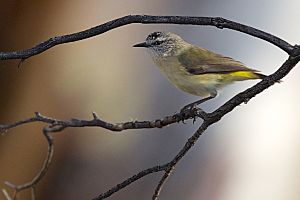Yellow-rumped thornbill facts for kids
Quick facts for kids Yellow-rumped thornbill |
|
|---|---|
 |
|
| Conservation status | |
| Scientific classification | |
| Genus: |
Acanthiza
|
| Species: |
chrysorrhoa
|
| Subspecies | |
|
|
 |
|
| Distribution of the yellow-rumped thornbill | |
The yellow-rumped thornbill (Acanthiza chrysorrhoa) is a small songbird found in Australia. It belongs to a bird family called Acanthizidae. There are four different types, or subspecies, of the yellow-rumped thornbill.
This bird is small and brownish. It has a bright yellow patch on its rump (its lower back). It also has a thin, dark beak. You can find these birds in many places across Australia, like grasslands, scrublands, and forests. They mostly eat insects. Yellow-rumped thornbills are also known for helping each other raise their young.
Contents
What's in a Name?
The yellow-rumped thornbill got its scientific name, Saxicola chrysorrhoa, in 1830. Two French naturalists, Jean René Constant Quoy and Joseph Paul Gaimard, described it. They found a specimen in King George Sound, Western Australia.
The name chrysorrhoa comes from Ancient Greek words. Khrysos means 'gold', and orrhos means 'rump'. So, its name literally means "gold-rumped."
Different Types of Yellow-rumped Thornbills
There are four recognized subspecies of this bird:
- chrysorrhoa: Found in Western Australia.
- leachi: Lives in Tasmania.
- leighi: Found in eastern Australia.
- normantoni: Lives in central and northern Australia.
Some Australian birdwatchers have a fun nickname for this bird: "Butterbum"! Scientists have studied the bird's DNA. They found that the yellow-rumped thornbill is an older type of thornbill. Its ancestors split off from other thornbills over 10 million years ago.
What Does It Look Like?
The yellow-rumped thornbill is the biggest type of thornbill. It is about 9.5–12 cm (3.7–4.7 in) long. It weighs around 9 g (0.32 oz). It has a short tail and a long, thin beak.
This bird has a very noticeable yellow rump. Its forehead is black with white spots. Its head and neck are grey. There's a white line above its eye and a white throat. Its belly is white, with light buff colors under its wings. The wings are grey, and the tail is black. The exact colors can be a little different depending on which subspecies it is.
How Does It Sound?
The yellow-rumped thornbill has a special song. People describe it as "twittering, musical, sweet, and high-pitched." These birds are also good at copying the sounds of other birds. They are especially known for mimicking the alarm calls of the noisy miner bird.
Where Do They Live?
Yellow-rumped thornbills live in many parts of Australia. You can find them in western, southern, and eastern Australia, as well as Tasmania. They are not found on the north coast of Western Australia. They are also absent from parts of central Australia, northern Queensland, and the northern Northern Territory.
These birds live in many different places. They like open forests, woodlands, grasslands, and scrublands.
What Do They Eat?
Yellow-rumped thornbills are insectivores. This means they mainly eat insects. Some of their favorite foods include ants, beetles, and bugs. They also eat tiny insects called lerps. Sometimes, they eat spiders, flies, and even seeds.
These birds usually look for food in small groups. A group can have anywhere from 3 to 12 birds. They might also join "mixed-species flocks." These are groups of different small insect-eating birds. Other birds in these flocks can include the speckled warbler, weebill, and other types of thornbills.
Life Cycle and Reproduction
Yellow-rumped thornbills usually breed from July to December. They can have one, two, or even more sets of babies each year. A pair of birds usually builds the nest. However, sometimes one to three helper birds will assist the breeding pair. This is called cooperative breeding.
The nest is a messy, dome-shaped structure. It is made of dried grass and other plants. The birds hide it low down in thick leaves or bushes. Sometimes they build it in vines or mistletoe. On top of the dome, there's a cup-shaped dip. This is a "false nest" to trick predators. The real nest is hidden inside, with a secret entrance.
The female bird lays three or four dull-white, oval eggs. The eggs have light red-brown spots, mostly at the wider end. Each egg is about 18 mm × 13 mm (0.71 in × 0.51 in). The female sits on the eggs to keep them warm. This takes about 16 to 18 days for them to hatch. Once the chicks hatch, both parents help feed them. The young birds stay in the nest for about 19 days.
Sometimes, other birds like the shining bronze-cuckoo or fan-tailed cuckoo lay their eggs in the thornbill's nest. Many other birds might try to eat the eggs or chicks. These include red wattlebirds, currawongs, Australian magpies, and ravens. Some honeyeaters might even destroy thornbill nests to steal nesting material. Studies show that yellow-rumped thornbills can live for up to nine years!
See also
 In Spanish: Acantiza culigualda para niños
In Spanish: Acantiza culigualda para niños


